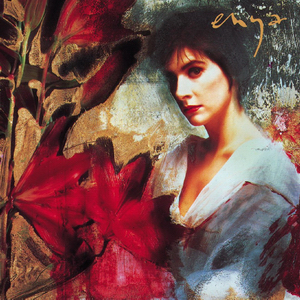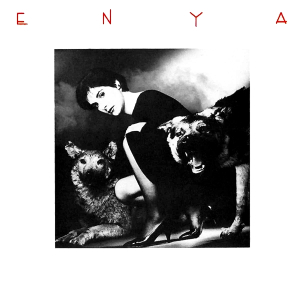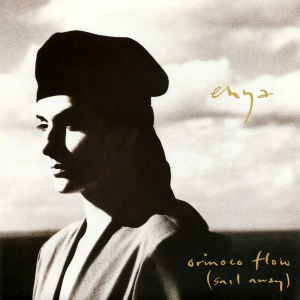A watermark is a recognizable image or pattern in paper used to determine authenticity.
Contents
Watermark or watermarking may also refer to:
A watermark is a recognizable image or pattern in paper used to determine authenticity.
Watermark or watermarking may also refer to:

Eithne Pádraigín Ní Bhraonáin, known mononymously as Enya, is an Irish singer, songwriter and musician, noted for her modern Celtic music. Enya is the best-selling Irish solo artist, and the second-best-selling Irish music act overall after the rock band U2.
Steganography is the practice of representing information within another message or physical object, in such a manner that the presence of the information is not evident to human inspection. In computing/electronic contexts, a computer file, message, image, or video is concealed within another file, message, image, or video. The word steganography comes from Greek steganographia, which combines the words steganós, meaning "covered or concealed", and -graphia meaning "writing".

Digital audio is a representation of sound recorded in, or converted into, digital form. In digital audio, the sound wave of the audio signal is typically encoded as numerical samples in a continuous sequence. For example, in CD audio, samples are taken 44,100 times per second, each with 16-bit sample depth. Digital audio is also the name for the entire technology of sound recording and reproduction using audio signals that have been encoded in digital form. Following significant advances in digital audio technology during the 1970s and 1980s, it gradually replaced analog audio technology in many areas of audio engineering, record production and telecommunications in the 1990s and 2000s.
Artifact or artefact may refer to:

A compression artifact is a noticeable distortion of media caused by the application of lossy compression. Lossy data compression involves discarding some of the media's data so that it becomes small enough to be stored within the desired disk space or transmitted (streamed) within the available bandwidth. If the compressor cannot store enough data in the compressed version, the result is a loss of quality, or introduction of artifacts. The compression algorithm may not be intelligent enough to discriminate between distortions of little subjective importance and those objectionable to the user.
Exile is either an entity who is, or the state of being, away from one's home while being explicitly refused permission to return.

Watermark is the second studio album by Irish singer, songwriter and musician Enya, released on 19 September 1988 by WEA. After the release of her previous album Enya (1987), she secured a recording contract with Warner after a chance meeting with chairman Rob Dickins, who had become a fan of her music. Her contract allowed her considerable artistic and creative freedom, with minimal interference from the label and no deadlines to have albums finished. Enya recorded Watermark in ten months with her longtime collaborators, manager, producer and arranger Nicky Ryan and his wife, lyricist Roma Ryan. It was initially recorded in Ireland in demo form before production relocated to London to re-record, mix, and master it digitally. Watermark features music in different styles, displaying Enya's sound of multi-tracked vocals with keyboards, percussion instruments, and elements of Celtic, ambient, and New-age music, though Enya believes her music does not belong in the latter genre.

Shepherd Moons is the third studio album by Irish singer, songwriter and musician Enya, released on 4 November 1991 by WEA. After the unexpected critical and commercial success of her previous album Watermark (1988), Enya embarked on a worldwide promotional tour to support it. At its conclusion, she wrote and rehearsed new material for her next album with her long time recording partners, manager, arranger and producer Nicky Ryan and his wife, lyricist Roma Ryan. The album was recorded in Ireland and London and continued to display Enya's sound of multi-tracked vocals with keyboards and elements of Celtic and new-age music.
A digital watermark is a kind of marker covertly embedded in a noise-tolerant signal such as audio, video or image data. It is typically used to identify ownership of the copyright of such signal. "Watermarking" is the process of hiding digital information in a carrier signal; the hidden information should, but does not need to, contain a relation to the carrier signal. Digital watermarks may be used to verify the authenticity or integrity of the carrier signal or to show the identity of its owners. It is prominently used for tracing copyright infringements and for banknote authentication.

Enya is the debut studio album by Irish singer, songwriter, and musician Enya, released in March 1987 by BBC Records in the UK and by Atlantic Records in the US. It was renamed as The Celts for the 1992 international re-release of the album by WEA Records in Europe and by Reprise Records in the US. The album features a selection of music that she recorded for the soundtrack to The Celts, a BBC documentary series about the origins, growth, and influence of Celtic culture.
Feedback is what occurs when outputs of a system are routed back as inputs as part of a chain of cause-and-effect that forms a circuit or loop.
Digital usually refers to something using discrete digits, often binary digits.

"Orinoco Flow", also released as "Orinoco Flow (Sail Away)", is a song by Irish singer-songwriter Enya from her second studio album, Watermark (1988). It was released on 3 October 1988 by WEA Records in the United Kingdom and by Geffen Records in the United States the following year. The song topped the UK Singles Chart for three weeks and received two Grammy Award nominations for Best Music Video and Best New Age Performance at the 32nd Annual Grammy Awards. The Guardian ranked "Orinoco Flow" at number 77 on its list of the 100 greatest UK number-one singles in 2020.
A fingerprint is a mark made by the pattern of ridges on the pad of a human finger.
A watermark stored in a data file refers to a method for ensuring data integrity which combines aspects of data hashing and digital watermarking. Both are useful for tamper detection, though each has its own advantages and disadvantages.
3-D,3D, or 3d may refer to:

Cinavia, originally called Verance Copy Management System for Audiovisual Content (VCMS/AV), is an analog watermarking and steganography system under development by Verance since 1999, and released in 2010. In conjunction with the existing Advanced Access Content System (AACS) digital rights management (DRM) inclusion of Cinavia watermarking detection support became mandatory for all consumer Blu-ray Disc players from 2012.
Decoder may refer to: